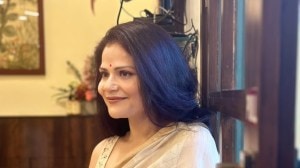Ideas in fibreglass
Is it wood, is it metal or is it stone? No! It's ...fibreglass - which can be treated in different ways to look like any of these. Fibreglas...

Is it wood, is it metal or is it stone? No! It’s …fibreglass – which can be treated in different ways to look like any of these. Fibreglass is fast gaining popularity as a medium to be used for various decorative purposes in construction work.
Hasmita Chauhan, a well-known artist in Pune, has considerable experience working with this medium. Actually Hasmita’s talents are multi-faceted. She is equally at home making terracotta figures, or doing stained glass, or painting on canvas. She has worked with some of the major builders and projects in the city. Holiday Inn commissioned her to do around 200 paintings and most of them adorn the corridors, a clay sculpture designed by her welcomes visitors as they enter the Residency Club. For Men’s Avenue on Laxmi Road, she painted their ceiling with a depiction of Michaelangelo’s famous rendering on the Sistine Chapel, The Bullocks on Nagar Road flaunts stained glass bearing her signature and numerous other private buildings too, have been decorated by her nimble fingers.
But nowhere perhaps does Hasmita’s talents find a greater and more varied outlet than in her use of fibreglass. At the Residency Club, she has done up the amusement park with bright lamps in the shape of parrots, pigeons and woodpeckers. For eight branches of the IndusInd banks in Pune, Cochin, Bangalore and elsewhere she has designed their logo of the Mohenjo-Daro seal with fibreglass made to resemble stone. A large mural at The Bullock’s looks like stonework but is actually Hasmita’s kamaal with fibreglass. At Dulhan, the jewellery store, she has again crafted a series of fireglass models which seem to be polished sandstone. There are jharokhas with a wood-finish, a sculptured Buddha, fountains with Greek figures and a rocky background, and street lamps which seem to be moulded out of metal. The common factor that runs through them is the fact that they are all made of fibreglass by Hasmita.
At present, Hasmita is working on a major project – a hotel on Karve Road where among other things, she is executing a eight-and-a-half feet sculpture of a Chinese doorman, a weather-cock in metal effect, fountains in rock effect and a number of lamps.
The vivacious artist demonstrates a sheet of this wonder material and explains how it is transformed. Fibreglass in its original form is soft, whitish in colour and comes in the form of mats, (much like the white jute gunny sacking one sees as the grocer’s). The mats are soaked in a hardener and a chemical solution which will give the required finish, whether it is wood, stone, metal or clay. The mats are now `stumped’ and moulded to shape – be it a sculpture or a half-relief figure.
“The fibreglass mats are difficult to work on,” reveals Hasmita, “because they make the hands itch. One cannot wear gloves for protection, because the chemicals we dip them in, are so strong that they will dissolve the gloves. But the advantage of this material is that it is light, durable, inexpensive and much easier to work with than with stone or metal.”
The very reasons that fibreglass has caught on in construction and decorative work. though synthetic, it looks and feels natural and in the process saves nature from being stripped of the naturally occurring materials. Just what an increasingly environmentally conscious world demands.
Photos


- 01
- 02
- 03
- 04
- 05





























